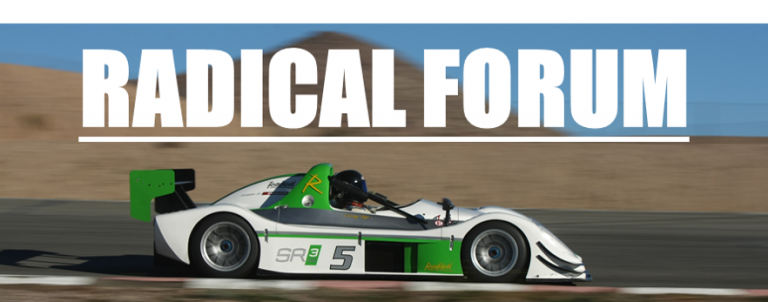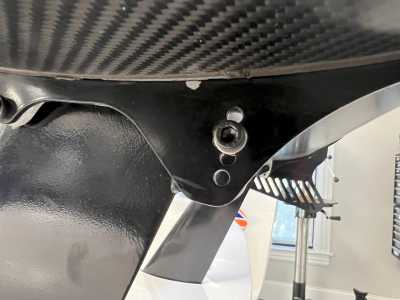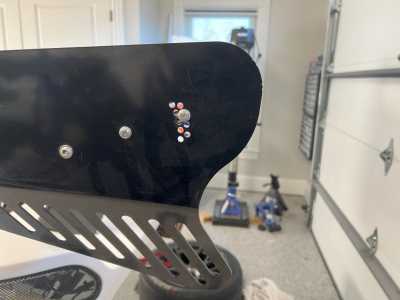
Just winging it
Can anyone point to a set of directions or something with some theory on how to adjust the double element carbon wing on a SR3?
So far I've been just using settings that I was given and then just winging it to try and make adjustments off that. I didn't see anything in the manual on adjustments.
Is the upper element a fine or coarse adjustment, likewise with the bottom/main element. Rule of thumb for settings to balance 1, 2 and no canards up front?
Really in the dark right now. First car with aero if you haven't already guessed and the last event I basically pulled wing and canards out of the car until it started to effect my ability to hold the car onto the trickier high speed corners. I figured that way I was still maximizing my corner speeds while hurting straight line speed as little as possible. Right idea or barking up the wrong tree?
@trakmnky, I haven't done a ton of experimenting with adjusting the aero because I like lots of downforce, but I can share what I have been told and experienced. Starting with the front, Adjustments to the dive planes should be done with corresponding changes to the rear wing. On high speed tracks you will find that high downforce limits your top speed too much and you can get faster times by lowering it. First try removing the top dive plane and making a slight change to the rear wing (I will get to the rear wing in a second). Then try removing both dive planes and making a change to the rear wing and see if the increase in top speed helps more than the loss in cornering downforce. As an example Autoclub speedway in California is a Roval track that has a long front straight, two high banked corners and two fairly long straights in the middle of the track. The best times on this track are achieved by taking off both front dive planes and lowering the flap on the rear wing.
Regarding the rear wing. I have always bee told to keep the main plane of the wing level and make all adjustments with the small flap. Small adjustments to the flap make considerable differences in the amount of downforce so make changes a half step at at a time and test it. There are two rows of holes on the RS (Gen 2) wing, which is what I have my experience on, and moving up or down to the hole in the other row is a half step and moving to the next hole on the same row is a full step. For example if you are on the 3rd hole up from the bottom on the top row of holes and move the 3rd hole from the bottom on the lower set of holes you have made a half step change. It is important to make half step changes because the car can become quite tail happy as the downforce is lowered.
So there is my advice. I would be interested to hear what others recommend.
Charley
Thanks Charley. This is close to what I was doing. It looks like we'll be going to Gingerman next weekend so I'll have more time to play with it. Hopefully others will provide some advice too.
Hi All, I basically have the same question that @trakmnky started this thread with, and I appreciate CharleyH's input above.
I was wondering if anyone has some data or aero-curves that would back up what we have been told?
There are only two tracks in my (island) State, both extremely different in terms of aero set-up. Symmons Plains is a fairly boring circuit to be honest and consists of just 5 corners and two straights, one of which is very long with a kink in the middle. The kink is taken flat out. Using the standard 3.071:1 GDU ratio and the aero settings that others have suggested I have struggled to reach the rev limiter on the longest straight (I routinely see 10,000 rpm at around 214km/hr). We have a race meeting there in a few weeks time and I'm going to experiment a bit with rear wing settings. I already run no front canards at this track on my RSX... so will stick to that. Removing the front canards and lowering the smaller bi-plane on the rear wing by half a hole (using the method to describe this above by CharleyH) gave me about 5km/hr improvement in to speed and improved overall lap time. I suspect more top speed will lead to further overall lap time improvement...
I have already been using the second lowest setting on the rear wing main plane at this track. (I use the third lowest setting and front canards (one per side) at the other circuit - Baskerville raceway - my favorite local track)
Does anyone have any experience with moving the main plane on the rear wing, and could help with advice on what to expect. I've been told that "nobody" uses the lowest setting on the rear wing main plane. Is there anyone who has tried it?
I have also been told that the smaller bi-plane adjustments have a much greater impact on downforce/drag than changes to the main plain (initially seems counter intuitive, but I can understand why that might be) I have plenty more room to further lower the smaller bi-plane in an attempt to increase top speed... but was basically wondering if there is a point where it would be better (more efficient downforce/drag ratio) to drop to the lowest setting on the main plain.
I used to help sponsor a young Tasmanian driver who was racing in Europe (2016-2022) and have a little experience with Tatuus Formula Renault and Dallara FIA F3 chassis' and note that they are supplied with aero curves that show the effect of front and rear wing settings (all planes), as well as how these interact with the rake of the chassis. I don't suppose anyone knows of something similar for our later model SR3's??
Any insights appreciated... before I launch into a full test while competing at the next event (testing and racing at the same time - never a perfect approach!)
Rod
Hi Rod @rjbender, to the best of my knowledge an aero chart does not exist for these cars… I have asked.
Regarding adjustments to the main wing. I have been told by Radical Set up experts that it is best to leave the main wing level and adjust downforce with the bi-plane. I am interested to see if anyone else has any different advice.
My perspective is just for SR3. TL;DR: hole 3 from the bottom on the main wing, 6 from the bottom on the subwing, and no diveplanes on the nose.
Very few race teams/drivers will run dive planes on the nose because the car makes sufficient downforce without them, and will have less drag. The only exception I have noticed was one time at Barber MSP (which is a short course with low top speed) during testing where a very fast driver added the front diveplanes; his times were about the same without the diveplanes so he raced without them. I never use front diveplanes except during the rain, and even without them the car still handles well in wet conditions.
I have used hole 2 and 3 from the bottom on the main wing and the difference is minor. I now just run hole three from the bottom for all tracks and conditions. The smaller subwing makes a significant difference in rear wheel grip for high speed corners (greater than 90/145 mph/kph). The user manual setup sheet suggests hole six from the bottom and I think this or hole 7 is a good start. 7 creates more drag but gives greater confidence. At Sebring last month all four SR3 drivers with Group-A Racing started with 7 from the bottom on the subwing which is especially helpful for turn 1 and 17 where those turns are very high speed and can be frightening. After two sessions, we dropped to hole 6, and I did not want to go lower because my car was dancing around through turn 1. At tracks that have a long straight such as Road America, Road Atlanta, COTA, etc., I prefer to trim the car out to hole 5, but if and when the tires lose grip, I will switch back to hole 6 -- particularly at COTA where it is easy to lose rear grip in the esses and sometimes in the carusel.
In wet conditions, I will disconnect the rear ARB (just zip tie the rod end in place), adjust dampers for wet setup, and run hole 7 in the rear wing. Time permitting, I will add the front diveplanes in wet conditions.
Also, if the car is not being pushed to the limit, then more or less rear subwing will not have a significant effect. In other words, some drivers will be very comfortable at hole 5 from the bottom on the rear subwing because the car is not at the limit of adhesion during high speed corners. Several other factors come into play such as the track, braking technique, tire pressure, camber, tire wear, etc. Aero is a quick adjustment, but it is not always the primary problem. Poor grip may be caused by incorrect tire pressure or old tires.
Edit: One other important consideration is rake, and in my preferences above, I use a base rake setting of +18mm according to the drop height setup table in the SR3 owner's manual. If for example you run less rake, this will alter the high speed dynamic weight distribution with less/more dynamic force on the front/rear tires, so naturally with less rake for example, the car would probably need less rear wing.
Posted by: @trakmnkyI didn't see anything in the manual on adjustments.
The Handling Guide has this to say about aero adjustments:
Adding more wing angle or diveplanes will give more aerodynamic grip. The trade-off here is ensuring that the gains made in cornering speed outweigh the inevitable losses in straight line speed.
This is a very brief description, but that is basically all there is to it. To determine whether a change has helped or hurt, one can analyse the difference in total time over any corner and following straight with RS Studio, comparing the fast laps before and after the adjustment.
The owners manuals for Gen 3 through 5 have a basic factory setup sheet which specify the aero settings for the rear main and subwing.
@davidf - Thanks David, Appreciate you sharing your replies. Just checking that when you say you run “hole 3 from the bottom” on the main plane that is actually the second lowest wing setting? (Ie with the main plain flatter than when in hole 2 for instance)
the reason for asking us just to clarify as I was taught on both planes to use the hole count with 1 being the lowest downforce setting and higher “hole numbers” being increasing downforce. I think your ‘numbering system’ is different and just want to correlate them.
I have used both hole 2 and 3 from the bottom (as you seem to define them) on the main plane as well… and have set the car for the next event with the longer straight to the ‘third hole up’ (second lowest downforce setting), with the bi-plane in hole 5 (from the lowest downforce position) as a starting point.
Rod
Hi Rod. Yes, and your way makes sense. On the main wing, lowest down force would be the 4th from the bottom. "From the bottom" is specified in the user manual setup sheet, and I have interpreted that as relative to the ground. Confusingly, the higher holes (relative to the ground) have higher and lower downforce on the subwing and main wing respectively.
A picture is worth a thousand words. This is how my car came from the factory and where I often start, which is 3rd hole from the bottom on the main wing and 6 from the bottom on the subwing.




